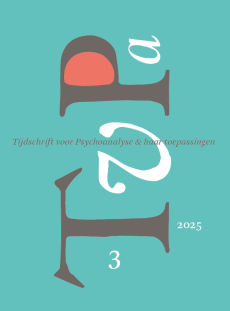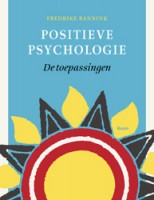Een goed geweten
Samenvatting
‹Het geweten heeft tot taak ervoor te zorgen dat het goed met je gaat› (Hokse 1983).1
Literatuur
- Bowlby, J. (1969). Attachment and loss. New York: Basic Books.
- Buchsbaum, H.K. & Emde, R.N. (1990). Play narratives in 36-month-old children: Early moral development and family relationships. Psychoanalytic Study of the Child, 45, 129-155.
- Cummings, E.M., Davies, P.T. & Campbell, S.B. (2000). Developmental psychopathology and family process – Theory, research, and clinical implications. New York: Guilford Press.
- Emde, R.N. (1983). The prerepresentational self and its affective core. Psychoanalytic Study of the Child, 38, 165-192.
- Emde, R.N. (1988a). Development terminable and interminable: I. Innate and motivational factors from infancy. International Journal of Psycho-Analysis, 69, 23-42.
- Emde, R.N. (1988b). Development terminable and interminable: II. Recent psychoanalytic theory and therapeutic considerations. International Journal of Psycho-Analysis, 69, 283-296.
- Emde, R.N. (1990). Mobilizing fundamental modes of development – Empathic availability and therapeutic action. Journal of the American Psychoanalytic Association, 38, 881-913.
- Emde, R.N. (1991). Positive emotions for psychoanalytic theory – Surprises from infancy research and new directions. Journal of the American Psychoanalytic Association, 39 (Suppl), 5-44.
- Emde, R.N. (1992). Social referencing research – Uncertainty, self, and the search for meaning. In S. Feinman (red.), Social referencing and the social construction of reality in infancy (p. 79- 94). New York: Plenum Press.
- Emde, R.N. (1994). Individual meaning and increasing complexity – Contributions of Sigmund Freud and Rene Spitz to developmental psychology. In R. D. Parke, P. A. Ornstein, J. J. Rieser & C. Zahn-Waxler (red.), A century of developmental psychology (p. 203-231). Washington: American Psychological Association.
- Emde, R.N. (2004). The present moment in psychotherapy and everyday life. International Journal of Psychoanalysis, 85, 1530-1534.
- Emde, R.N., Biringen, Z., Clyman, R.B. & Oppenheim, D. (1991). The moral self of infancy – Affective core and procedural knowledge. Developmental Review, 11, 251-270.
- Emde, R.N. & Buchsbaum, hh.k.k. (1990). ‹Didn’t you hear my mommy?› Autonomy with connectedness in moral selfemergence. In D. Cicchetti & M. Beeghly (red.), The self in transitio – Infancy to childhood. The John D. and Catherine T. MacArthur foundation series on mental health and development (p. 35- 60). Chicago: University of Chicago Press.
- Emde, R.N. & Hewitt, J.K. (red.). (2001). Infancy to early childhood – Genetic and environmental influences on developmental change. New York: Oxford University Press.
- Emde, R.N., Johnson, W.F. & Easterbrooks, M.A. (1987). The do’s and don’ts of early moral development – Psychoanalytic tradition and current research. In J. Kagan & S. Lamb (red.), The emergence of morality in young children (p. 245-276). Chicago: University of Chicago Press.
- Emde, R.N. & Oppenheim, D. (1995). Shame, guilt, and the Oedipal drama – Developmental considerations concerning morality and the referencing of critical others. In J. P. Tangney & K. W. Fischer (red.), Self conscious emotions – The psychology of shame, guilt, embarrassment, and pride (p. 413-436). New York, NY: Guilford Press.
- Emde, R.N. & Slotkin, P. (1999). Moving ahead – Integrating influences of affective processes for development and for psychoanalysis. International Journal of Psychoanalysis, 80, 317-339.
- Emde, R.N., Wolf, D. & Oppenheim, D. (2003). Revealing the inner worlds of young children – Using the MacArthur story stem battery and parent-child narratives. New York: Oxford University Press.
- Erikson, E.H. (1984). Reflections on the last stage – and the first. Psychoanalytic Study of the Child, 39, 155-165.
- Finkelstein, L. (1991). Neglected aspects of the superego. Journal of the American Academy of Psychoanalysis and Dynamic Psychiatry, 19, 530-554.
- Freud, S. (1923). Das Ich und das Es. Psychologie des Unbewußten (p. 273-331), Studienausgabe Band III. Frankfurt am Main: S. Fischer, 2de druk 1978.
- Hoffman, M.L. (1977). Empathy, its development and prosocial implications. Nebraska Symposium on Motivation, 25, 169-217.
- Killen, M. & Smetana, J.G. (2006). Handbook of moral development. Mahwah NJ: Lawrence Erlbaum Associates.
- Klinnert, M.D., Emde, R.N., Butterfield, P. & Campos, J.J. (1986). Social referencing – The infant’s use of emotional signals from a friendly adult with mother present. Developmental Psychology, 22(4), 427-432.
- Kochanska, G. (1991). Socialization and temperament in the development of guilt and conscience. Child Development, 62, 1379-1392.
- Kochanska, G. (1993). Toward a synthesis of parental socialization and child temperament in early development of conscience. Child Development, 64, 325-347.
- Kochanska, G. (1994). Beyond cognition – Expanding the search for the early roots of internalization and conscience. Developmental Psychology, 30, 20-22.
- Kochanska, G. (2002a). Mutually responsive orientation between mothers and their young children – A context for the early development of conscience. Current Directions in Psychological Science, 11, 191-195.
- Kochanska, G. (2002b). Committed compliance, moral self, and internalization – A mediational model. Developmental Psychology, 38, 339-351.
- Kochanska, G., Aksan, N., & Koenig, A.L. (1995). A longitudinal study of the roots of preschoolers’ conscience – Committed compliance and emerging internalization. Child Development, 66, 1752-1769.
- Kochanska, G. & Aksan, N. (2004 a). Development of mutual responsiveness between parents and their young children. Child Child Development, 75(6), 1657-1676.
- Kochanska, G. & Aksan, N. (2004b). Conscience in childhood – Past, present, and future. Merrill Palmer Quarterly, 50, 299-310.
- Kochanska, G., Forman, D.R., Aksan, N. & Dunbar, S.B. (2005). Pathways to conscience – Early mother-child mutually responsive orientation and children’s moral emotion, conduct, and cognition. Journal of Child Psychology and Psychiatry, 46, 19-34.
- Kohlberg, L. & Kramer, R. (1969). Continuities and discontinuities in childhood and adult moral development. Human Development, 12, 3-120.
- Kuczynski, L. & Kochanska, G. (1990). Development of children’s noncompliance strategies from toddlerhood to age 5. Developmental Psychology, 26, 398-408.
- Kuhl, P.K. (2000). A new view of language acquisition – National Acad Sciences.
- Kurtines, W.M. & Gewirtz, J.L. (1991). Handbook of moral behavior and development. Hillsdale NJ: L. Erlbaum.
- Lampl-de Groot, J. (1962). The genesis of ego substructures. Psychoanalytic Study of the Child, 17, 94-106.
- Loewenstein, R.M. & Hartmann, H. (1966). Psychoanalysis – A general psychology. New York: International Universities Press.
- Nagera, H. (1963). The developmental profile – Notes on some practical considerations regarding its use. The psychoanalytic study of the child, 18, 511-540.
- Oppenheim, D., Emde, R.N., Hasson, M. & Warren, S. (1997). Preschoolers face moral dilemmas – A longitudinal study of acknowledging and resolving internal conflict. International Journal of Psycho-Analysis, 78, 943-957.
- Piaget, J. & Gabain, M. (1932). The moral judgment of the child. Londen: K. Paul, Trench, Trubner & Co. ltd.
- Sandler, J. (1960). On the concept of superego, Psychoanalytic Study of the Child, 15, 128-162.
- Sandler, J., Kawenoka, M., Neurath, L., Rosenblatt, B., Schnurmann, A. & Sigal, J. (1962). The classification of superego material in the Hampstead index. Psychoanalytic Study of the Child, 17, 107-127.
- Smeekens, S. (2007). Patterns of competence and adaptation in preschoolers and their developmental antecedents – A longitudinal study. Proefschrift Radboud Universiteit Nijmegen.
- Sroufe, L.A., Duggal, S., Weinfield, N.S. & Carlson, E. (2000). Relationships, development, and psychopathology. In A. J. Sameroff, M. Lewis & S.M. Miller (red.), Handbook of developmental psychopathology (2nd ed.) (p. 75-91). New York: Kluwer Academic / Plenum Press.
- Stern, D.N. (1985). The interpersonal world of the infant – A view from psychoanalysis and developmental psychology. New York: Basic Books.
- Trevarthen, C. (1979). Communication and cooperation in early infancy. A description of primary intersubjectivity. In M. Bullowa (red.), BEFORE SPEECH – THE BEGINNING OF HUMAN COMMUNICATION (p. 321-347). Londen: Cambridge University Press.
- Trevarthen, C. (2001). Intrinsic motives for companionship in understanding – Their origin, development, and significance for infant mental health. Infant Mental Health Journal, 22, 95-131.
- Trevarthen, C. & Aitken, K.J. (2001). Infant intersubjectivity – Research, theory, and clinical applications. Journal of child psychology and psychiatry, and allied disciplines, 42, 3-48.
- Van Bakel, H. (2002). Infants and their parents – Development in a social context. Proefschrift Katholieke Universiteit Nijmegen.
- Vliegen, N., Meurs, P. & Cluckers, G. (2002). Hoe moeders in beeld blijven – Emdes visie op de ontwikkeling van moederbeelden en zelfrepresentaties. Tijdschrift voor Psychoanalyse, 8, 205-221.
- Zahn Waxler, C. & Kochanska, G. (1990). The origins of guilt. In R. A. Thompson (red.), (1990). Nebraska Symposium on Motivation, 1988: Socioemotional development – Current theory and research in motivation, Vol. 36 (p. 183-258). Lincoln NE: University of Nebraska Press.
- Zahn Waxler, C., Schmitz, S., Fulker, D., Robinson, J. & Emde, R. (1996). Behavior problems in 5-year-old monozygotic and dizygotic twins – Genetic and environmental influences, patterns of regulation, and internalization of control. Development and Psychopathology, 8, 103-122.
 © 2009-2025 Uitgeverij Boom Amsterdam
© 2009-2025 Uitgeverij Boom Amsterdam
ISSN 1382-516x
De artikelen uit de (online)tijdschriften van Uitgeverij Boom zijn auteursrechtelijk beschermd. U kunt er natuurlijk uit citeren (voorzien van een bronvermelding) maar voor reproductie in welke vorm dan ook moet toestemming aan de uitgever worden gevraagd:
Behoudens de in of krachtens de Auteurswet van 1912 gestelde uitzonderingen mag niets uit deze uitgave worden verveelvoudigd, opgeslagen in een geautomatiseerd gegevensbestand, of openbaar gemaakt, in enige vorm of op enige wijze, hetzij elektronisch, mechanisch door fotokopieën, opnamen of enig andere manier, zonder voorafgaande schriftelijke toestemming van de uitgever.
Voor zover het maken van kopieën uit deze uitgave is toegestaan op grond van artikelen 16h t/m 16m Auteurswet 1912 jo. Besluit van 27 november 2002, Stb 575, dient men de daarvoor wettelijk verschuldigde vergoeding te voldoen aan de Stichting Reprorecht te Hoofddorp (postbus 3060, 2130 KB, www.reprorecht.nl) of contact op te nemen met de uitgever voor het treffen van een rechtstreekse regeling in de zin van art. 16l, vijfde lid, Auteurswet 1912.
Voor het overnemen van gedeelte(n) uit deze uitgave in bloemlezingen, readers en andere compilatiewerken (artikel 16, Auteurswet 1912) kan men zich wenden tot de Stichting PRO (Stichting Publicatie- en Reproductierechten, postbus 3060, 2130 KB Hoofddorp, www.cedar.nl/pro).
No part of this book may be reproduced in any way whatsoever without the written permission of the publisher.
Nieuwsbrief Boom Psychologie
Meld u nu aan en ontvang maandelijks de Boom Psychologie nieuwsbrief met aantrekkelijke aanbiedingen en de nieuwe uitgaven.
Aanmelden


